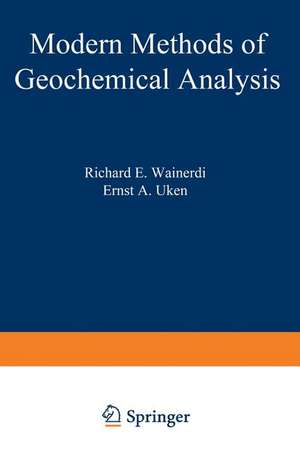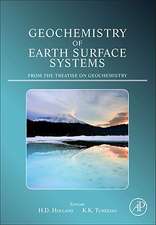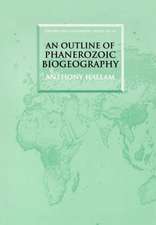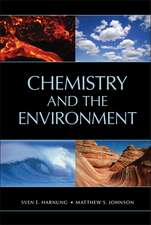Modern Methods of Geochemical Analysis: Monographs in Geoscience
Editat de Richard Wainerdien Limba Engleză Paperback – 12 dec 2012
Preț: 645.28 lei
Preț vechi: 759.15 lei
-15% Nou
Puncte Express: 968
Preț estimativ în valută:
123.47€ • 129.26$ • 102.17£
123.47€ • 129.26$ • 102.17£
Carte tipărită la comandă
Livrare economică 05-19 aprilie
Preluare comenzi: 021 569.72.76
Specificații
ISBN-13: 9781468418323
ISBN-10: 1468418327
Pagini: 416
Ilustrații: XVIII, 398 p. 31 illus.
Dimensiuni: 152 x 229 x 22 mm
Greutate: 0.55 kg
Ediția:Softcover reprint of the original 1st ed. 1971
Editura: Springer Us
Colecția Springer
Seria Monographs in Geoscience
Locul publicării:New York, NY, United States
ISBN-10: 1468418327
Pagini: 416
Ilustrații: XVIII, 398 p. 31 illus.
Dimensiuni: 152 x 229 x 22 mm
Greutate: 0.55 kg
Ediția:Softcover reprint of the original 1st ed. 1971
Editura: Springer Us
Colecția Springer
Seria Monographs in Geoscience
Locul publicării:New York, NY, United States
Public țintă
ResearchCuprins
1 Introduction.- 1. Classical Definition of Geochemistry.- 2. The Role of Geochemical Analysis.- 3. Summary.- 2 Statistics.- 1. Introduction.- 2. Basic Concepts.- 3. Measures of Location and Dispersion.- 4. Frequency Distributions.- 5. Standard Error.- 6. Tests of Significance.- 7. Regression.- 8. Analysis of Variance.- 9. Sampling Methods.- 10. Statistical Tables.- 11. Applications to Analytical Methods.- References.- 3 Chemical Analysis and Sample Preparation.- 1. Introduction.- 2. Sample Preparation.- 3. Dissolution of Geologic Samples.- 4. Methods of Separation.- 5. Methods of Determination.- 6. Advantages, Disadvantages, and Limitations of Wet Chemical Analyses.- References.- 4 Ion-Exchange Chromatography.- 1. Introduction.- 2. Ion-Exchanging Materials.- 3. Ion-Exchange Selectivity.- 4. Anion-Exchange Separations of Metals.- 5. Mixed Solvents in Ion-Exchange Separations.- 6. Special Ion-Exchange Techniques.- 7. Applications to Geochemical Analysis.- References.- 5 Colorimetry.- 1. Introduction.- 2. Theoretical Considerations.- 3. Instrumentation.- 4. Sample Preparation.- 5. Photometric Measurements.- 6. Applications.- References.- 6 Infrared Spectrometry.- 1. Introduction.- 2. Techniques of Sample Presentation.- 3. Quantitative Applications in Geochemistry.- 4. Mineral Identification with Infrared.- 5. Crystal-Chemistry Studies.- References.- 7 Optical Emission Spectroscopy.- 1. Introduction.- 2. Equipment and Facilities.- 3. Techniques.- 4. Geochemical Applications.- 5. Literature.- 6. Evaluation of the Method.- 7. Future Developments.- References.- 8 Atomic Absorption.- 1. Introduction.- 2. Principles of Atomic Absorption.- 3. Apparatus.- 4. Sensitivity, Accuracy, and Interferences.- 5. Analysis of Geologic Samples by Atomic Absorption.- 6. Geochemical Prospecting.- 7. Recent and Future Developments.- References.- 9 X-Ray Techniques.- 1. Introduction.- 2. Theoretical Considerations.- 3. Instrumentation.- 4. X-Ray Diffraction.- 5. X-Ray Absorptiometry.- 6. X-Ray-Emission Spectrography.- References.- 10 Radiometric Technique.- 1. Introduction.- 2. Fundamentals.- 3. Radiation Detectors.- 4. Radiometric Prospecting.- 5. Quantitative Determination of Natural Radioelements.- 6. Radiometric Age Determinations.- References.- 11 Nuclear Activation Analysis.- 1. Introduction.- 2. Reactor-Thermal-Neutron Activation Analysis.- 3. 14-MeV Neutron Activation Analysis.- 4. Charged-Particle and Photon Activation Analyses.- 5. Activation Analysis in the Geosciences.- 5.1. Mineral Prospecting.- 5.2. Logging Techniques.- 5.3. Ore Sorting.- References.- 12 Mass Spectrometry.- 1. Introduction.- 2. Stable Carbon-and Oxygen-Isotope Mass Spectrometry.- 3. Trace-Element-Concentration Determination by Spark-Source Mass Spectrometry.- References.

























